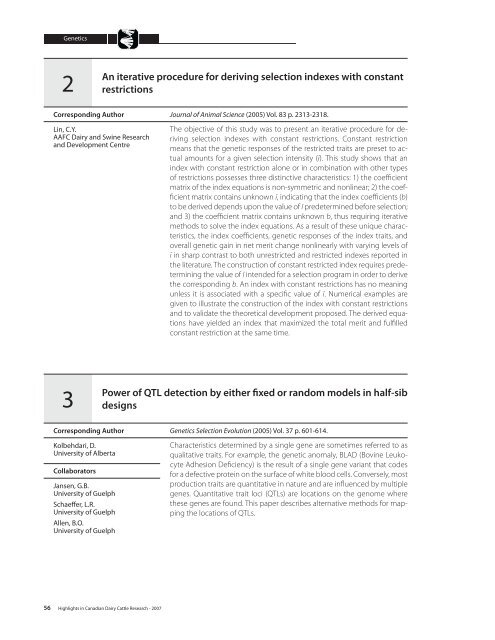A52-75-2007E.pdf - AgroMedia International Inc
A52-75-2007E.pdf - AgroMedia International Inc
A52-75-2007E.pdf - AgroMedia International Inc
You also want an ePaper? Increase the reach of your titles
YUMPU automatically turns print PDFs into web optimized ePapers that Google loves.
Genetics2An iterative procedure for deriving selection indexes with constantrestrictionsCorresponding AuthorLin, C.Y.AAFC Dairy and Swine Researchand Development CentreJournal of Animal Science (2005) Vol. 83 p. 2313-2318.The objective of this study was to present an iterative procedure for derivingselection indexes with constant restrictions. Constant restrictionmeans that the genetic responses of the restricted traits are preset to actualamounts for a given selection intensity (ī). This study shows that anindex with constant restriction alone or in combination with other typesof restrictions possesses three distinctive characteristics: 1) the coefficientmatrix of the index equations is non-symmetric and nonlinear; 2) the coefficientmatrix contains unknown ī, indicating that the index coefficients (b)to be derived depends upon the value of ī predetermined before selection;and 3) the coefficient matrix contains unknown b, thus requiring iterativemethods to solve the index equations. As a result of these unique characteristics,the index coefficients, genetic responses of the index traits, andoverall genetic gain in net merit change nonlinearly with varying levels ofī in sharp contrast to both unrestricted and restricted indexes reported inthe literature. The construction of constant restricted index requires predeterminingthe value of ī intended for a selection program in order to derivethe corresponding b. An index with constant restrictions has no meaningunless it is associated with a specific value of ī. Numerical examples aregiven to illustrate the construction of the index with constant restrictionsand to validate the theoretical development proposed. The derived equationshave yielded an index that maximized the total merit and fulfilledconstant restriction at the same time.3Power of QTL detection by either fixed or random models in half-sibdesignsCorresponding AuthorKolbehdari, D.University of AlbertaCollaboratorsJansen, G.B.University of GuelphSchaeffer, L.R.University of GuelphAllen, B.O.University of GuelphGenetics Selection Evolution (2005) Vol. 37 p. 601-614.Characteristics determined by a single gene are sometimes referred to asqualitative traits. For example, the genetic anomaly, BLAD (Bovine LeukocyteAdhesion Deficiency) is the result of a single gene variant that codesfor a defective protein on the surface of white blood cells. Conversely, mostproduction traits are quantitative in nature and are influenced by multiplegenes. Quantitative trait loci (QTLs) are locations on the genome wherethese genes are found. This paper describes alternative methods for mappingthe locations of QTLs.56 Highlights in Canadian Dairy Cattle Research - 2007





